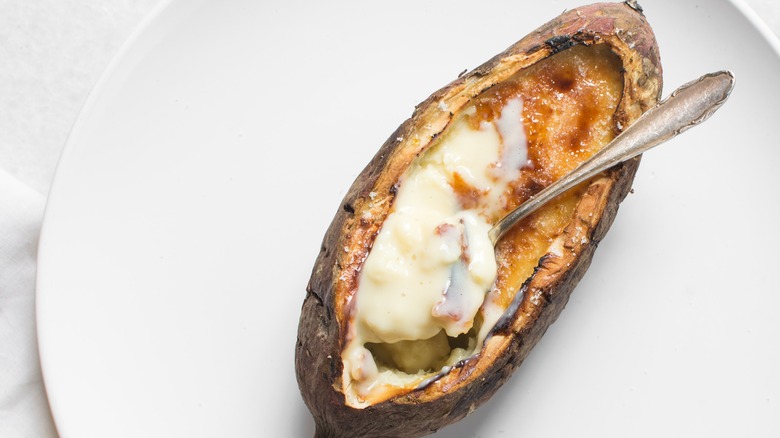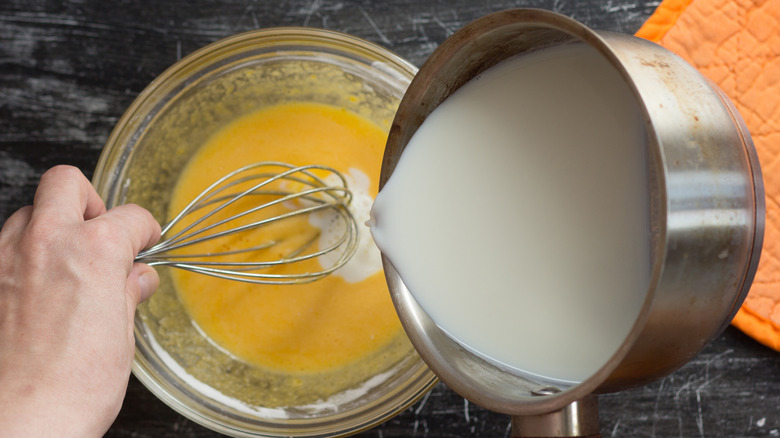Reinvent Your Crème Brûlée By Making It Inside A Sweet Potato
Crème brûlée may be a dessert to try when you're visiting Paris, but there's a Japanese spin on it that might make you rethink everything you know about how the flame-fired custard is made. That's right, you can totally reinvent your crème brûlée by making it inside of a Japanese sweet potato.
Normally, you'd combine the ingredients for your custard and cook it in a ramekin in a water bath, but a hollowed-out Japanese sweet potato, called satsumaimo, makes a delicious vessel. Not only does its sweet and earthy flavor enhance the deep, toasty notes of the vanilla cream, but its tender flesh melts into the custard for a smooth yet surprisingly light dessert. Top it off with the signature torched caramelized sugar and you are in for a treat.
Sweet potato crème brûlée originated as a street food at Imo Pippi in Asakusa, Tokyo, and has since gained popularity online for its unique take on the classic dish. Fans rave about the creative presentation and incredible taste.
How to make crème brûlée in a sweet potato, step-by-step
This dessert might be visually impressive, but it's actually pretty easy to make. Step one is roasting your sweet potatoes. Wash and dry your potatoes and poke some holes in them with a fork to allow steam to escape during the baking process. You can roast them bare or wrapped in aluminum foil. Foil-wrapped sweet potatoes tend to turn out more fluffy and cake-like on the inside, which can be beneficial for beefing up your custard later.
Speaking of custard, you'll whip that up while the potatoes are baking. Mix egg yolks, sugar, milk, and heavy cream and heat until slightly thickened. By the time that's done, your potatoes should be nearly ready. Allow them to cool before slicing them down the middle. Be careful with your cut, as you don't want to puncture the bottom or the sides completely, or your custard will spill out before it has set.
Watch on TikTok
Next, take a fork and separate the potato flesh from the skin. You may need to remove some of the interior, but you want to keep a good portion of it inside the skin. Use the fork to mash down the flesh into the bottom of the potato skin before pouring your custard into the vessel. Some recipes call for popping these custard-filled sweet potatoes back into the oven to fully set, while others add the sugar topping right away at this stage and torch it.
What makes a Japanese sweet potato perfect for this dessert
While you can use a regular sweet potato for this dish, if you can get your hands on an actual satsumaimo, it's worth it. Unlike the more familiar orange-fleshed sweet potatoes that we're used to in the U.S., the Japanese version has a distinctive purple-reddish skin and a pale whitish-yellow inside. The flavor is a lot sweeter — almost nutty — and more concentrated, and it intensifies when roasted. Some say the smell of roasted satsumaimo is just like caramel.
Another key characteristic of Japanese sweet potatoes is their texture. When cooked, the flesh becomes creamy, almost buttery, and fluffy, which sets it apart from the softer, more moist texture of orange sweet potatoes. That's because Japanese varieties contain more starch than their American counterparts.
Similar to orange sweet potatoes, though, Japanese sweet potatoes are also nutritionally rich, packing a punch of vitamins A and C, plus dietary fiber and potassium. They're also fat-free and contain very little sodium.


